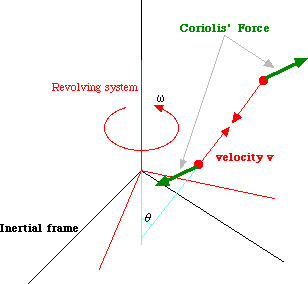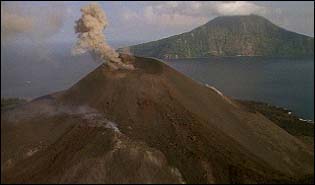
Because the Earth is a globe spinning on an invisible axis, a point at its equator will make a circuit of 25,000 miles in the space of a day, but any point not on the equator will make a shorter round trip; the closer that point is to either of the poles, the shorter its trip will be. Put another way, a pencil at the equator travels 1,030 miles an hour, whereas another at Sarasota, Florida, moves at 930 miles per hour, and one at the North pole doesn't move at all.
This apparent difference in speed results in the Coriolis force, an effect that imparts a twist to largish events happening away from the equator. Best known is its effect on air masses: as they move away from the equator, their speed (which matches that of where they started from) appears to be faster than that of the surface over which they are traveling. This sets them turning in a clockwise twist in the northern hemisphere and a counterclockwise twist in the southern. Likewise, a cannonball fired due north will veer a teeny bit to the east, and one fired to the south will deflect ever so slightly to the west, something a skilled gunner would make an adjustment for.
The twisting effect of the Coriolis force is real and does influence certain large things like the movement of air masses,
but the effect is so small that it plays no role in determining the direction in which water rotates as it exits from a draining sink or toilet. The Coriolis effect produces a measurable effect over huge distances and long periods of time, neither of which applies to your bathroom. Toilets and sinks drain in the directions they do because of the way water is directed into them or pulled from them. If water enters in a swirling motion (as it does when a toilet is flushed, for example), the water will exit in that same swirling pattern; as well, most basins have irregular surfaces and are not perfectly level, factors which influence the direction in which water spirals down their drains. The configuration of taps and drains is responsible for the direction of spin given to water draining from sinks and bathtubs to a degree that overwhelms the slight influence of the Coriolis force.
The belief that the Coriolis force influences the direction in which water drains from plumbing fixtures is widespread and has been repeated as fact in a number of venues, including popular television shows (such as world traveler Michael Palin's Pole to Pole) and even in textbooks. We can only speculate on why people are so enamored of this snippet of misinformation, guessing that it has something to do with the desire to find some of the mysteries of science in the realm of the everyday.
¡¡¡ES una leyenda urbana!!! ¿Nos vamos a Australia a comprobarlo?
A todo esto, lo he sacado de
AQUÍ
 Imagínate que un huracán sacude tu ciudad.
Imagínate que un huracán sacude tu ciudad. Munch tenía unos veinte años cuando un atardecer de 1883, según contó en su diario, «estaba caminando con dos amigos. Entonces se puso el sol. De momento todo el cielo era rojo sangre, y me sobrecogió una gran melancolía. Me quedé quieto y me recosté al borde del camino, me sentía muy cansado, nubes como sangre y lenguas de fuego caían sobre la ciudad y sobre los fiordos azules y negros. Mis amigos continuaron caminando y yo me quedé solo, temblando de ansiedad. Sentí como si un gran grito interminable atravesara la naturaleza».
Munch tenía unos veinte años cuando un atardecer de 1883, según contó en su diario, «estaba caminando con dos amigos. Entonces se puso el sol. De momento todo el cielo era rojo sangre, y me sobrecogió una gran melancolía. Me quedé quieto y me recosté al borde del camino, me sentía muy cansado, nubes como sangre y lenguas de fuego caían sobre la ciudad y sobre los fiordos azules y negros. Mis amigos continuaron caminando y yo me quedé solo, temblando de ansiedad. Sentí como si un gran grito interminable atravesara la naturaleza».  La sección de "Gente" de El País vuelve a llamarme la atención. Marla Olmstead es la última sensación del mercado artístico de Nueva York. Ha vendido todos los cuadros que expuso en una galeria del Soho. El último de ellos alcanzó un precio de seis mil dolares. Lo más curioso de todo es que la autora apenas tiene cuatro años.
La sección de "Gente" de El País vuelve a llamarme la atención. Marla Olmstead es la última sensación del mercado artístico de Nueva York. Ha vendido todos los cuadros que expuso en una galeria del Soho. El último de ellos alcanzó un precio de seis mil dolares. Lo más curioso de todo es que la autora apenas tiene cuatro años. Because the Earth is a globe spinning on an invisible axis, a point at its equator will make a circuit of 25,000 miles in the space of a day, but any point not on the equator will make a shorter round trip; the closer that point is to either of the poles, the shorter its trip will be. Put another way, a pencil at the equator travels 1,030 miles an hour, whereas another at Sarasota, Florida, moves at 930 miles per hour, and one at the North pole doesn't move at all.
Because the Earth is a globe spinning on an invisible axis, a point at its equator will make a circuit of 25,000 miles in the space of a day, but any point not on the equator will make a shorter round trip; the closer that point is to either of the poles, the shorter its trip will be. Put another way, a pencil at the equator travels 1,030 miles an hour, whereas another at Sarasota, Florida, moves at 930 miles per hour, and one at the North pole doesn't move at all.